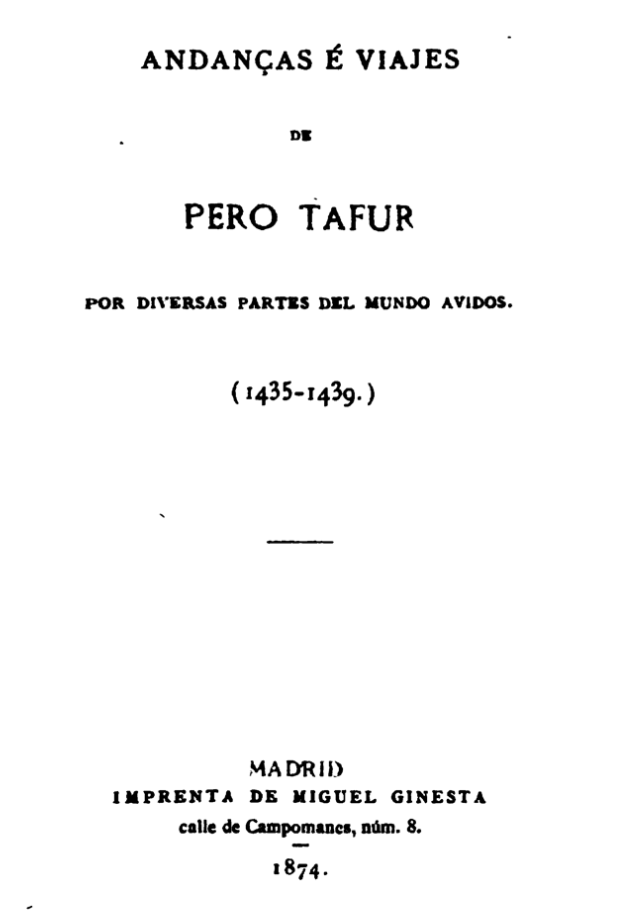Source: Manuscript, 1442-1455, Florence, Biblioteca del Seminario Arcivescovile Maggiore, Codice Rustici
Edition: Kathleen Olive and Nerida Newbigin, eds., Il Codice Rustici. Edizione critica, in: Dimostrazione dell’andata, o viaggio al Santo Sepolcro e al Monte Sinai di Marco di Bartolomeo Rustici (Florence: Leo S. Olschki, 2015), 1:95-298.
Il secondo libro del Santo Sepolcro e del monte Sinai
9. Partìmoci de la cità di Firenze, io Marco con mia compagnia, per montare in galea
“Dirimpetto, a non tropi pasi, v’è un cimitero, chiamasi il Campo Santo, magnifico e bello, coperto di piombo; e nel mezo è pieno di sipulture di rilievo, intagliate di nobile istorie, il quale i Pisani dificorono e fondorono della terra la quale egli arecorono per zacora da’ navili di Gerusaleme dal Santo Sipolcro.” (171 (fol. 89v))
The second book of the Holy Sepulchre and Mount Sinai
9. We depart from the city of Florence, me, Marco, and my company, in order to board the ship.
In front of this, in a distance of not too many footsteps, there is a cemetery which is called Camposanto, magnificent and beautiful, covered with lead. And in the center it is full of sculptured sepulchres, incised with noble stories. The Pisans built it and founded it with the earth that they brought with [??] ships from the Holy Spulchre of Jerusalem.
2. Istoria del santo viagio in Gerusaleme ed al monte Sinai e in Arabia
49. I dodici apostoli feciono il Credo
“Salendo sù pel muro inverso levante, sendo in cima èvi piano coperto di terra. Ha di sopra VI finestre; guatando di quindi ivi si vede quel campo il quale i Giudei comperarono de’ XXX danari di Cristo che Giuda il vendé e quel campo è pien di sipulture di pelegrini. Chiamasi il detto campo Acheldama. Tutti i pelegrini vi sono sopeliti. Chi vàe in detto campo si dice sua orazione co riverenzia e co requiem etternam per l’anime di coloro che sopeliti vi sono Cristiani. Chiamasi Campo Santo. Ècci di perdono anni VII dìe LXX.
E i Pisani anticamente signoregiorono il Sipolcro e per vettoria e trionfo recorono di quella terra di quello campo; con divozione dificorono nella città di Pisa uno cimitero chiamato Campo Santo magnifico e bello, coperto di piombo, a grolia di Dio.” (264 (fol. 237v))
History of the holy travel to Jerusalem, to mount Sinai and to Arabia
49. The twelve apostles did the Creed
Climbing up on the wall towards the east, there is on top an area which is covered with earth. There are six windows, and from there the field can be seen which the Jews bought with the 30 coins of Christ when sold him. And this field is full of sepulchres of pilgrims. And this field is called Acheldama. All the pilgrims are buried there. Whoever goes to this field says his prayer with reverence and with requiem aeternam for the souls of the Christians who are buried there. It is called Campo Santo. And the indulgence is seven years and seventy days.
In ancient times the Pisans ruled over the Sepulchre and, as a sign of victory and triumph, they brought some earth from that field. In Pisa, they devoutly built up a wonderful and beautiful, lead-covered cemetery called Campo Santo for God’s glory.

 Pero Tafur (c. 1410 –c. 1484) was a nobleman from a Castilian family who participated in military campaigns of the Reconquista before he undertook a long journey around the Mediterrenean and across several parts of central Europe and Italy between 1436 and 1439. Although he visited Jerusalem and Palestine in the first part of his trip, his principal interest was more as an adventurer and religious themes played no particular role. Tafur composed the written account of his journey only several yeas later, in 1453/54. While he visited Pisa on the way to Rome, at the very beginning of his trip, the lengthy description of the city that we reproduce here is included in the very last chapters of the book, when Tafur was en route to Spain. His account of Pisa’s history is very characteristic for the entire book, as it relies exclusively on heresay and is full of phantastic and historically impossible claims. The central aim of this highly ficticious narrative is to give an explanation for Pisa’s decline, from a powerful sea republic to a satellite of Florence. In this framework, Pisa’s decision to sell Jerusalem is seen as the principle reason for its ultimate defeat. Therefore, the Camposanto plays a prominent role here, as a “container” of the holy earth. / DG
Pero Tafur (c. 1410 –c. 1484) was a nobleman from a Castilian family who participated in military campaigns of the Reconquista before he undertook a long journey around the Mediterrenean and across several parts of central Europe and Italy between 1436 and 1439. Although he visited Jerusalem and Palestine in the first part of his trip, his principal interest was more as an adventurer and religious themes played no particular role. Tafur composed the written account of his journey only several yeas later, in 1453/54. While he visited Pisa on the way to Rome, at the very beginning of his trip, the lengthy description of the city that we reproduce here is included in the very last chapters of the book, when Tafur was en route to Spain. His account of Pisa’s history is very characteristic for the entire book, as it relies exclusively on heresay and is full of phantastic and historically impossible claims. The central aim of this highly ficticious narrative is to give an explanation for Pisa’s decline, from a powerful sea republic to a satellite of Florence. In this framework, Pisa’s decision to sell Jerusalem is seen as the principle reason for its ultimate defeat. Therefore, the Camposanto plays a prominent role here, as a “container” of the holy earth. / DG